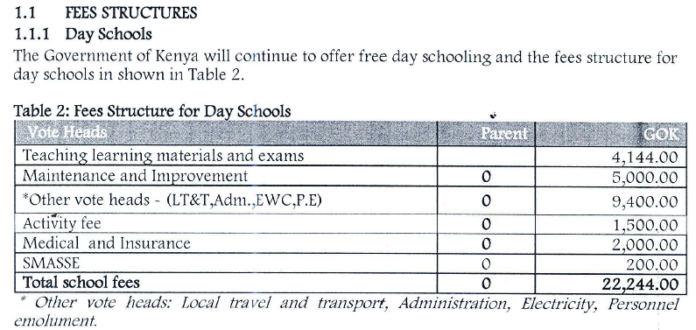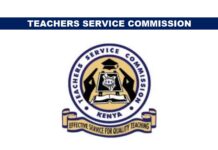
The ministry of Education has realized the plan of school heads of raising school fees charged from the parents for their children’s upkeep in school when the schools re open. Due to the harsh and long protests by the parents over extra fees charged from them secretly by the school principals, The ministry has now decided to warn all school heads over raising the school fees. Hence they gave a clear school fees structure.
Through the ministry’s online platform the warning came up this way “The ministry of education has not asked the secondary schools to raise school fees. Any school that increases school fees should be reported to the ministry”
Note what the CS education had said:
In the year 2019 the principals through their association KESSHA were complaining and wished that they should charge extra fee from the parents. The association claimed that the ministry of education slashed more than a half of the funds allocated to them for Free day secondary education.
Professor Magoha in response to that,gave power to the school principals to charge for extra cash from parents. Magoha while addressing the KEPSHA delegates on third dec 2019, gave the heads a greenlight to charge parents extra fee.
In his speech, the CS was so categorical,as he said they should charge the fee to aid in establishment and improvement of infrastructure.
school fee structure guideline structure for 2020 for every school type:
Disbursement of capitation to schools will done in the ratio 50:30:20. The first disbursement will be effected in December 2019 and subsequent ones in April 2020 and August 2020.
Use of enrollment data of NEMIS:
- Term one 2020: 30th November 2019.
- Term two 2020: 30th March 2020.
- Term three 2020: 30th July 2020.
Schools are support to record all names of the students to enhance full funding by the government. The Government subsidy is given to public primary and secondary schools under the following conditions:
- School should be registered and be under a TSC appointed principal.
- The school must be registered on the NEMIS platform
- The school must register and update learners records in the NEMIS platform
- All bank accounts operated by the school should be registered in NEMIS and with MoE at all its levels.
costs to be met by parents:
Parents will have to purchase uniforms
- School uniforms;
- Boarding shoppings for personal upkeep of the student. Thats as stated in the school admission letter.
- Lunch for the day scholars; and
- Clear their fees balances for continuing students prior to Jan 2020.
FEES STRUCTURES for Day Schools 2020
The Government of Kenya will continue to offer free day schooling and the fees structure for day schools in shown in Table below;
|
VOTE HEADS |
PARENT |
GOK |
|
Teaching learning materials and exams |
0 |
4,144.00 |
|
Maintenance and Improvement |
0 |
5,000.00 |
|
*Other vote heads - (LT&T,Adm.,EWC,P.E) |
0 |
9,400.00 |
|
Activity fee |
0 |
1,500.00 |
|
Medical and Insurance |
0 |
2,000.00 |
|
SMASSE |
0 |
200.00 |
|
Total school fees |
0 |
22,244.00 |
FEES STRUCTURE FOR BOARDING SCHOOL 2020
The government will provide capitation for each learner in a boarding school that is equal to capitation for each learner in a day school. Hence due to accommodation,school development charges,bus fee and tour fees, the parents for boarding school students are required to pay extra fee as per location and type of school.
Schools classification ( category A)
Schools classified as Category A are: –
- All National schools and
- Extra county schools that are located in the following towns: Nairobi, Mombasa, Nakuru, Kisumu, Nyeri, Thika and Eldoret ONLY.
Fee structure for boarding schools category (A)
|
VOTE HEADS |
GOK |
PARENT |
TOTAL |
|
Teaching learning materials and exams |
4,144.00 |
0 |
4,144.00 |
|
Boarding Equipment and Store |
0 |
30,385.00 |
30,385.00 |
|
Maintenance and Improvement |
5,000.00 |
2,000.00 |
7,000.00 |
|
*Other vote heads -(LT&T,Adm.,EWC,P.E) |
9,400.00 |
20, 371.00 |
29,771.00 |
|
Activity fee |
1,500.00 |
798.00 |
2,298.00 |
|
Medical and Insurance |
2,000.00 |
– |
2,000.00 |
|
SMASSE |
200.00 |
– |
200.00 |
|
Total school fees |
22,244.00 |
53, 554.00 |
75,798.00 |
Boarding Schools (Category B)
Schools classified as Category B are other boarding schools including extra county schools that are located in other areas other than the town of Nairobi, Mombasa, Nakuru, Kisumu, Nyeri, Thika and Eldoret.)
BBoarding school’s fees structure- category (B)
|
VOTE HEADS |
GOK |
PARENT |
TOTAL |
|
Teaching learning materials and exams |
4,144.00 |
0 |
4,144.00 |
|
Boarding Equipment and Store |
0 |
25,385.00 |
25,385.00 |
|
Maintenance and Improvement |
5,000.00 |
2,000.00 |
7,000.00 |
|
*Other vote heads -(LT&T,Adm.,EWC,P.E) |
9,400.00 |
12,900.00 |
22,300.00 |
|
Activity fee |
1,500.00 |
250.00 |
1,750.00 |
|
Medical and Insurance |
2,000.00 |
– |
2,000.00 |
|
SMASSE |
200.00 |
– |
200.00 |
|
Total school fees |
22,244.00 |
40,535.00 |
62,779.00 |
Fees Structure for Special Needs Schools 2020;
Schools classified as Special needs schools are schools that cater for learners who are physically or mentally impaired. e.g. visual, physical, hearing and mental. GOK has enhanced capitation to KES. 57,974.00 distributed in the fees structure shown in Table below;
|
VOTE HEADS |
GOK |
PARENT |
TOTAL |
|
Teaching learning materials and exams |
4,144.00 |
0 |
4,144.00 |
|
Boarding Equipment and Store |
23,220.00 |
10,790.00 |
34,010.00 |
|
Maintenance and Improvement |
5,000.00 |
2,000.00 |
7,000.00 |
|
Other vote heads -(LT&T,Adm.,EWC,P.E) |
9,400.00 |
0 |
9,400.00 |
|
Activity fee |
1,500.00 |
0 |
1,500.00 |
|
Medical and Insurance |
2,000.00 |
0 |
2,000.00 |
|
Top up |
12,510.00 |
0 |
12,510.00 |
|
SMASSE |
200.00 |
0 |
200.00 |
|
Total school fees |
57,974.00 |
12,790.00 |
70,764.00 |
BANK ACCOUNTS
To ensure accountability and smooth implementation of the FDSE programme, all schools are required to operate the following bank accounts. –
Tuition account: for banking of tuition funds and all payments should strictly be made by cheques. Funds in the tuition account must be utilized for the procurement of teaching and learning material (TLMs) only.
Operational Account: – This account is used for banking of all Government subsidies except the tuition. Infrastructure Grants as well as Maintenance and improvement funds should be transferred to the school infrastructure Account thirty days upon receipt of the funds
Boarding Account: – This account for banking of funds paid by parents for boarding related expenses.
A Saving Account: This account is for banking funds from the Boarding Account Cash Book that cannot be put to immediate use.
School Infrastructure Account: – for banking infrastructure grants from GoK and Maintenance and Improvement (M&I) funds. It is illegal to spend grants from any other account. Therefore all grants must be transferred whole into this account.
Schools with income generating activities shall open separate bank accounts for the same. School who receive NGCDF support must open an account for the project as provided for by the CDF Act.
OPERATIONAL PROCEDURES FOR SCHOOL BANK ACCOUNTS
In addition to the above, the following procedures will continue to apply:
- Each account must have a separate cash book;
- All schools must acknowledge the receipt of funds by a letter to the CDE/uploading an official receipt on the NEMIS plat form;
- A receipt is issued to every learner for the capitation amount received for every disbursement; d) Schools must post on their notice boards the amounts received;
- Schools have the freedom to operate a fourth bank account to cater for development funds;
- No virement is authorized from the Tuition Account;
- All CDF and donations or funds from Harambee must be receipted officially and entered into the school Cash books. These include incomes from hire of school facilities e.g. grounds, classrooms, halls or billboards on school compounds.
FINANCIAL OBLIGATIONS
All schools’ management, especially, principals, are expected to ensure prudence in the use of school funds and to adhere to the laid down financial regulations as stipulated in the reviewed Handbook on Financial Management for Public Secondary Schools, Teacher Training Colleges And Technical And Vocational Colleges In Kenya issued by the MOE, the Public Finance Management Act, 2012 and the Public Procurement and Disposal Act, 2015.
All stipulated accounting procedures and other necessary measures, including cost-saving, must be adhered to by all schools at all times. In addition, the following will apply:-
- Schools shall NOT enter into financial contracts e.g. Hire purchase, bank loans or mortgages without the express written approval of the Cabinet Secretary in line with Section 18 of 4th Schedule of the Basic Education Act, 2013.
- Every principal shall be responsible for application and utilization of funds as the accounting officer of the school. Guidelines of the same shall be given before the actual disbursement.
GUIDELINES FOR BOARD OF MANAGEMENT (BOM) EMPLOYEES
MOE will continue to disburse funds to support the BOM employees. To minimize the cost of secondary education it is necessary to rationalize the recruitment of such cadre of staff. It shall be the responsibility of the boards to hire Non–Teaching Staff at terms commensurate with qualification and capacity to pay. It is also important for schools to hire persons who are qualified for the job.
TRANSFERS AND RE-ENTRY
Cases of re–admission of dropouts and transfer should be dealt with on individual basis and as stipulated in the student transfer guidelines. All transfers must be handled through the NEMIS system.
ENROLMENT DATA
It shall be the responsibility of the principal to ensure accurate data is available in NEMIS and every student is fully registered on the platform. Every student has been issued with a UPI number. This must be used at all time during admission and transfers. Transfers of students should be avoided in the course of the academic year and may only be sanctioned by the Director General under special circumstances. Disbursement of capitation will be done using the data available in the system. Schools which received capitation for students above the enrollment will be penalized and the principal surcharged for loss of public resources as provided for in Public Finance Management Act, 2012 Sections 197,198 and 202.
Schools enrollment data in NEMIS as at 30th November 2019 will be used to disburse funds for term one of 2020. Principals are therefore required to update their records in NEMIS. Hence forth, any change of bank accounts will be effected at the head quarter with school request for change forwarded by the sub county director of education.
MAINTENANCE AND IMPROVEMENT FUNDS
Ministry of Education has made a decision to review to Ksh.5,000 per student the amount for M&I per year to cater for ensuring a proper learning environment with adequate school infrastructure and other improvements. Similarly, for boarding schools, an additional KSh 2,000 is provided for. This vote should only be used for immovable assets and other form of infrastructure in the school that may require upgrading. Approval must be sought from the relevant office on utilization of the funds under this vote. Detailed guidelines will be issued on the approval of projects under this fund.
INSURANCE AND STUDENTS MEDICAL COVER BY NHIF
The Ministry of Education entered into a contract with National Hospital Insurance Fund (NHIF), which requires the latter to offer comprehensive medical cover to all the students in public secondary schools with effect from 1st May 2018.
Principals are therefore required to acquaint themselves with the terms of the cover to ensure that students access quality health services from NHIF accredited health facilities and cease requesting parents to meet medical expenses. Schools are required to fully register a student in NEMIS for a NHIF number to be generated to ease students accessing services even when on holiday.
Students should be advised to inform their parents about the UPI numbers. In addition all school principals should sent death notification letters to the Principal Secretary within seven (7) days of death of any student in their schools and also help their parents/guardians fill a claim form for last expense and group life benefits payment.
The Ministry will retain Ksh.1350 from the medical vote head to fund the medical cover. The rest of the vote head funds will be disbursed to schools to meet insurance related expenses.
INELIGIBLE EXPENDITURES
As stipulated in the Public Finance Management (PFM) Act, 2012,
i) Every public officer employed in a public entity shall comply with the Constitution and all laws relating to the conduct of public officers when carrying out a responsibility or exercising a power under this Act.
ii) Without prejudice to PFM Act provisions, a public officer shall ensure that the resources in his/her purview are used in a way, which is
(a) lawful and authorized; and
(b) Effective, efficient, economical and transparent;
iii) All procurement of goods and services is to be carried out in accordance with Article 227 of the Constitution and the relevant legislation on procurement and disposal of assets.
iv) An Accounting Officer may not authorize payment to be made out of funds earmarked for specific activities for other purposes other than those activities.
Ineligible expenditure will arise when such expenditures do not adhere to the law and are not aligned towards the goal of students learning, which are the school‘s main activities.











